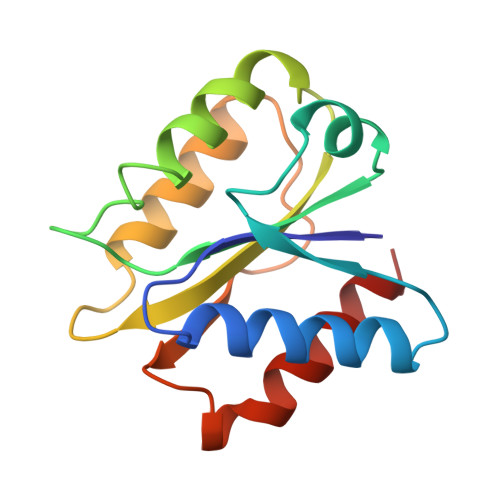Control of oxidation-reduction potentials in flavodoxin from Clostridium beijerinckii: the role of conformation changes.
Ludwig, M.L., Pattridge, K.A., Metzger, A.L., Dixon, M.M., Eren, M., Feng, Y., Swenson, R.P.(1997) Biochemistry 36: 1259-1280
- PubMed: 9063874
- DOI: https://doi.org/10.1021/bi962180o
- Primary Citation of Related Structures:
1FLA, 1FLD, 1FLN, 1FVX, 2FAX, 2FDX, 2FLV, 2FOX, 2FVX, 3NLL, 4NLL, 4NUL, 5NLL, 5NUL, 5ULL, 6NUL - PubMed Abstract:
X-ray analyses of wild-type and mutant flavodoxins from Clostridium beijerinckii show that the conformation of the peptide Gly57-Asp58, in a bend near the isoalloxazine ring of FMN, is correlated with the oxidation state of the FMN prosthetic group. The Gly-Asp peptide may adopt any of three conformations: trans O-up, in which the carbonyl oxygen of Gly57 (O57) points toward the flavin ring; trans O-down, in which O57 points away from the flavin; and cis O-down. Interconversions among these conformers that are linked to oxidation-reduction of the flavin can modulate the redox potentials of bound FMN. In the semiquinone and reduced forms of the protein, the Gly57-Asp58 peptide adopts the trans O-up conformation and accepts a hydrogen bond from the flavin N5H [Smith, W. W., Burnett, R. M., Darling, G. D., & Ludwig, M. L. (1977) J. Mol. Biol. 117, 195-225; Ludwig, M. L., & Luschinsky, C. L. (1992) in Chemistry and Biochemistry of Flavoenzymes III (Müller, F., Ed.) pp 427-466, CRC Press, Boca Raton, FL]. Analyses reported in this paper confirm that, in crystals of wild-type oxidized C. beijerinckii flavodoxin, the Gly57-Asp58 peptide adopts the O-down orientation and isomerizes to the cis conformation. This cis form is preferentially stabilized in the crystals by intermolecular hydrogen bonding to Asn137. Structures for the mutant Asn137Ala indicate that a mixture of all three conformers, mostly O-down, exists in oxidized C. beijerinckii flavodoxin in the absence of intermolecular hydrogen bonds. Redox potentials have been manipulated by substitutions that alter the conformational energies of the bend at 56M-G-D-E. The mutation Asp58Pro was constructed to study a case where energies for cis-trans conversion would be different from that of wild type. Intermolecular interactions with Asn137 are precluded in the crystal, yet Gly57-Pro58 is cis, and O-down, when the flavin is oxidized. Reduction of the flavin induces rearrangement to the trans O-up conformation. Redox potential shifts reflect the altered energies associated with the peptide rearrangement; E(ox/sq) decreases by approximately 60 mV (1.3 kcal/mol). Further, the results of mutation of Gly57 agree with predictions that a side chain at residue 57 should make addition of the first electron more difficult, by raising the energy of the O-up conformer that forms when the flavin is reduced to its semiquinone state. The ox/sq potentials in the mutants Gly57Ala, Gly57Asn, and Gly57Asp are all decreased by approximately 60 mV (1.3 kcal/mol). Introduction of the beta-branched threonine side chain at position 57 has much larger effects on the conformations and potentials. The Thr57-Asp58 peptide adopts a trans O-down conformation when the flavin is oxidized; upon reduction to the semiquinone, the 57-58 peptide rotates to a trans O-up conformation resembling that found in the wild-type protein. Changes in FMN-protein interactions and in conformational equilibria in G57T combine to decrease the redox potential for the ox/sq equilibrium by 180 mV (+4.0 kcal/mol) and to increase the sq/hq potential by 80 mV (-1.7 kcal/mol). A thermodynamic scheme is introduced as a framework for rationalizing the properties of wild-type flavodoxin and the effects of the mutations.
- Department of Biological Chemistry, University of Michigan, Ann Arbor 48109-1055, USA.
Organizational Affiliation:

















